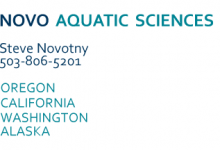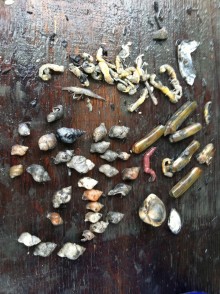

MonitoringNovo Aquatic Sciences, Inc. provides a range of Monitoring Services for Our Clients:
Fisheries Monitoring Novo Aquatic provides Fisheries Monitoring to Our Clients throughout various aquatic habitats - from small streams to large rivers, as well as estuaries and bays. Novo Aquatic currently provides Real Time monitoring for the US Army Corps of Engineers annual maintenance dredging projects in the Stockton and Sacramento ship channels, assessing presence of fish of concern and vulnerability to entrainment by hydraulic dredge operations. Since 2011, Novo Aquatic Sciences has provided biological services for the fish entrainment monitoring of San Francisco Bay dredging operations aboard the 300' USACE hopper dredge Essayons.
Novo Aquatic will always strive to minimize mortality rates during Fisheries Monitoring for Our Clients. Sampling mortality is weighed and justified from the standpoint of research need, government mandate, and species conservation measures, as well as cultural and ethical considerations.
Aquatic Macroinvertebrate Monitoring Novo Aquatic provides macroinvertebrate study sample design, collection / identification, and analytical services. We monitor aquatic insects and other aquatic organisms to provide Our Clients useful data for assessment of the physical, biological, and chemical conditions of water bodies. Aquatic invertebrates are readily accessible and provide biological evidence of impacts that affect aquatic ecosystem health. While some insects and other invertebrates are highly tolerant to pollution, others are more sensitive and long-lived, thus providing usefulness to Our Clients in aquatic assessment from overall water quality to acute pollution events.
Collection of typical water quality parameters include: water temperature, dissolved oxygen, pH, conductivity, salinity, turbidity, and pH. Novo Aquatic can also provide Our Clients customized monitoring for analyzing other water quality parameters, including the presence of specific chemicals and metals in water and river sediments. Fish Monitoring for Hydraulic Dredging OperationsTo permit deep water ship channel maintenance dredging operations in the Sacramento and San Joaquin Rivers, the National Marine Fisheries Service (NMFS) mandated fish monitoring in the channels and at the points of discharge. There are two primary monitoring methods conducted on alternating days with occasional night sampling for comparative purposes.
1) Fish Community Monitoring: To characterize the affected fish community, short-duration, scientific bottom trawl surveys are conducted to describe fish use in the channel during active dredging operations. Simply put, this method describes presence of fish in the channel near the dredge during operations.
Concurrent entrainment studies are conducted at the point of discharge from dredging operations to determine the type and amount of fish directly taken and impacted by the dredge operation.
2) Dredge Entrainment Monitoring: Involves screening the dredge output at the point of discharge using a mobile entrainment screen. This screen is a prototype constructed in early 2008. The sampling prototype is custom designed to efficiently assess the amount and species of fish being directly taken by dredging operations. Simply put, this method describes which fish (if any) present in the channel are being entrained by dredging operations.
Typical Results of Dredging Operations Include:
All data collected is incorporated into a designated database that streamlines electronic field data entry and enables examination of the complex relationships between fish presence, biological characteristics, and other environmental factors. Some environmental variables tracked with fish monitoring include: water quality, tide, time, current flow, and the presence or absence of other species. This monitoring program provides data to refine the take estimates of ESA-listed fishes. Thus, this program also enables assessment of changes to the fish community resulting from management actions, anthropogenic influences, and/or other environmental fluctuations or perturbations. |


